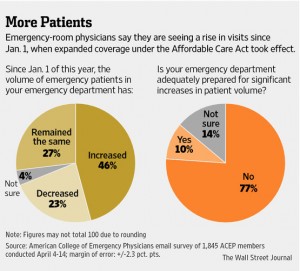ER Visits Rise Despite Health Law
May 21 | Posted by mrossol | ObamaCareMight be too early to draw hard conclusions, but interesting….
=======
Early evidence suggests that emergency rooms have become busier since the Affordable Care Act expanded insurance coverage this year, despite the law’s goal of reducing unnecessary care in ERs.
Almost half of ER doctors say they are seeing more patients since key provisions of the health law took effect Jan. 1, while more than a quarter say their patient volume has remained the same, according to a survey to be released Wednesday by the American College of Emergency Physicians.
Eighty-six percent of emergency doctors expect visits to rise over the next three years, though the email survey didn’t ask the doctors why.
Democrats who designed the 2010 health law hoped it would do the opposite. They wanted to give the uninsured better access to primary-care doctors who could treat routine ailments and prevent chronic disease, with the intent of keeping patients out of the ER and lowering the cost of care. The median ER charge was more than $1,200 for the most frequent outpatient diagnoses in a study of over 8,000 ER visits in 2006-08, said a 2013 report funded in part by the National Institutes of Health.
Instead, the ER doctor group’s research and several other recent studies suggest that people who gain private and government insurance are more likely to seek emergency care.
Among the reasons is that a shortage of primary-care providers in some regions has made it difficult for some patients to get appointments, according to the ER doctor group, although some other research disputes there is such a problem.
Erin Shields Britt, a spokeswoman for the Department of Health and Human Services, said it was too soon to draw broad conclusions from the study. “This survey, looking at only the first three months of coverage, cannot speak to the long-term effects of expanded coverage, which will be shaped by our continuing efforts to help people use their new primary care and preventive care benefits and to invest in innovative approaches aimed at improving our nation’s system of primary care,” she said.
Stephen Pitts, an associate professor in the emergency medicine department at Emory University School of Medicine, said it is misguided to attribute the increased volume to the health law since “there’s been a relentless increase in ER volume over the past 25 years.”
ER physicians met Tuesday with lawmakers on Capitol Hill to press for a congressional hearing on the law’s impact on ERs, such as longer wait times.
“The ACA is going to stretch EDs [emergency doctors] further and that has implications for how quickly we can get people through,” said Robert O’Connor, chairman of emergency medicine at the University of Virginia School of Medicine in Charlottesville and the doctor group’s vice president. The group’s survey was conducted in April and received 1,845 responses.
In Oregon, which expanded Medicaid coverage in 2008, ER visits rose 40% over 18 months among low-income residents who gained coverage compared with those who didn’t, according to a January report in the journal Science.
After Massachusetts implemented its own system of near-universal insurance in 2006, ER visits rose an estimated 2.2% a year through September 2009, according to a study to be published in August in the Annals of Emergency Medicine.
Other research suggests that primary-care doctors aren’t seeing more visits. New patients accounted for 17% of primary-care visits in this year’s first quarter, down from 17.9% in the year-earlier period, according to a survey of 12,700 physicians by ACAView, a partnership of Athenahealth Inc. ATHN -0.07% and the Robert Wood Johnson Foundation.
In four states that expanded Medicaid Jan. 1, Tenet Healthcare Corp. THC +2.29% saw 25% more Medicaid ER visits in the first quarter compared with a year earlier. The rise was partly offset by a decline in ER visits by uninsured people. Overall, including states that didn’t expand Medicaid, Tenet saw ER volumes rise 2.7%.
“It’s all right with us [because] we run hospitals with emergency rooms, but in terms of the overall cost to the system, you’d want them to find care in a different setting,” said Trevor Fetter, Tenet’s chief executive officer, in an interview.
In Phoenix, Banner Good Samaritan Medical Center typically reduces its ER staff up to 7% as wintertime residents leave the area. Not this year. A rise in ER volume means patients face a delay in getting a room, a slight increase in wait times and no plans to curb summer staffing, said Moneesh Bhow, medical director of the emergency department.
In Napa, Calif., St. Joseph Health Queen of the Valley Medical Center is putting patients in the hallways on a regular basis due to ER crowding, said Paul Kivela, a managing partner of Napa Valley Emergency Medical Group and secretary-treasurer at the emergency-doctors group.
Rep. Michael Burgess (R., Texas), a former OB-GYN, said he wasn’t surprised by the findings. “It was a specious argument” that the law would reduce ER use, he said.
—Melinda Beck and Christopher Weaver contributed to this article.






Leave a Reply
You must be logged in to post a comment.